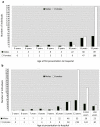Self-harm in children 12 years and younger: characteristics and outcomes based on the Multicentre Study of Self-harm in England
- PMID: 34282487
- PMCID: PMC8761160
- DOI: 10.1007/s00127-021-02133-6
Self-harm in children 12 years and younger: characteristics and outcomes based on the Multicentre Study of Self-harm in England
Abstract
Background: Very little is known about self-harm in children. We describe the characteristics and outcomes of children under 13 years who presented following self-harm to five hospitals in England.
Methods: We included children under 13 years who presented after self-harm to hospitals in the Multicentre Study of Self-harm in England. Information on patients' characteristics and method of self-harm was available through monitoring of self-harm in the hospitals. Area level of socioeconomic deprivation was based on the English Index of Multiple Deprivation (IMD).
Results: 387 children aged 5-12 years presented to the study hospitals in 2000-2016, 39% of whom were 5-11 years. Boys outnumbered girls 2:1 at 5-10 years. The numbers of boys and girls were similar at age 11, while at 12 years there were 3.8 girls to every boy. The proportion of study children living in neighbourhoods ranked most deprived (43.4%) was twice the national average. 61.5% of children self-poisoned, 50.6% of them by ingesting analgesics. Of children who self-injured, 45.0% self-cut/stabbed, while 28.9% used hanging/asphyxiation. 32% of the children had a repeat hospital presentation for self-harm, 13.5% re-presented within a year.
Conclusions: Gender patterns of self-harm until age 11 years are different to those of adolescents, with a male preponderance, especially in 5-10 years, and hanging/suffocation being more common. The frequent use of self-poisoning in this age group highlights the need for public health messages to encourage safer household storage of medicines. Self-harm in children is strongly associated with socioeconomic deprivation; understanding the mechanisms involved could be important in effective prevention.
Keywords: Adolescents; Children; Methods; Self-harm; Socioeconomic disadvantage.
© 2021. The Author(s).
Conflict of interest statement
KH and NK declare Grants from the National Institute for Health Research. NK also declares funding from the Health Quality Improvement Partnership and that he chairs the National Institute of Health and Care Excellence (NICE) depression guideline committee and is topic advisor for the new NICE self-harm guideline. All other authors declare no competing interests. KH is a National Institute for Health Research (NIHR) Senior Investigator (Emeritus). The views expressed are those of the authors and not necessarily those of the NHS, the NIHR, or the Department of Health and Social Care.
Figures



Similar articles
-
Suicide following presentation to hospital for non-fatal self-harm in the Multicentre Study of Self-harm: a long-term follow-up study.Lancet Psychiatry. 2019 Dec;6(12):1021-1030. doi: 10.1016/S2215-0366(19)30402-X. Epub 2019 Nov 6. Lancet Psychiatry. 2019. PMID: 31706930
-
Mortality in children and adolescents following presentation to hospital after non-fatal self-harm in the Multicentre Study of Self-harm: a prospective observational cohort study.Lancet Child Adolesc Health. 2020 Feb;4(2):111-120. doi: 10.1016/S2352-4642(19)30373-6. Epub 2020 Jan 8. Lancet Child Adolesc Health. 2020. PMID: 31926769
-
Incidence of suicide, hospital-presenting non-fatal self-harm, and community-occurring non-fatal self-harm in adolescents in England (the iceberg model of self-harm): a retrospective study.Lancet Psychiatry. 2018 Feb;5(2):167-174. doi: 10.1016/S2215-0366(17)30478-9. Epub 2017 Dec 12. Lancet Psychiatry. 2018. PMID: 29246453
-
Self-harm in children and adolescents by ethnic group: an observational cohort study from the Multicentre Study of Self-Harm in England.Lancet Child Adolesc Health. 2021 Nov;5(11):782-791. doi: 10.1016/S2352-4642(21)00239-X. Epub 2021 Sep 21. Lancet Child Adolesc Health. 2021. PMID: 34555352 Free PMC article.
-
Self-harm in England: a tale of three cities. Multicentre study of self-harm.Soc Psychiatry Psychiatr Epidemiol. 2007 Jul;42(7):513-21. doi: 10.1007/s00127-007-0199-7. Epub 2007 May 21. Soc Psychiatry Psychiatr Epidemiol. 2007. PMID: 17516016
Cited by
-
Self-harm and suicidal behaviors in children: perspectives of mental health clinicians.J Pediatr Psychol. 2024 Aug 1;49(8):571-579. doi: 10.1093/jpepsy/jsae044. J Pediatr Psychol. 2024. PMID: 38872281 Free PMC article.
-
Deliberate Self-Harm Among Youth in the Child Welfare System.JAACAP Open. 2025 Apr 16;3(3):506-515. doi: 10.1016/j.jaacop.2025.04.002. eCollection 2025 Sep. JAACAP Open. 2025. PMID: 40922759 Free PMC article.
-
Self-harm in 5-to-24 year olds: Retrospective examination of hospital presentations to emergency departments in New South Wales, Australia, 2012 to 2020.PLoS One. 2023 Aug 10;18(8):e0289877. doi: 10.1371/journal.pone.0289877. eCollection 2023. PLoS One. 2023. PMID: 37561714 Free PMC article.
-
Family Economic Hardship and Non-Suicidal Self-Injury Among Chinese Adolescents: Relative Deprivation as a Mediator and Self-Esteem as a Moderator.Behav Sci (Basel). 2024 Dec 22;14(12):1234. doi: 10.3390/bs14121234. Behav Sci (Basel). 2024. PMID: 39767375 Free PMC article.
-
Current Phenomenon of Self-Harm in Children and Adolescents.J Korean Acad Child Adolesc Psychiatry. 2025 Apr 1;36(2):47-53. doi: 10.5765/jkacap.250003. J Korean Acad Child Adolesc Psychiatry. 2025. PMID: 40203140 Free PMC article. Review.
References
-
- Studart-Botto P, Martins-Junior DF, Sarmento S, Argolo L, Galvao-de-Almeida A, Miranda-Scippa A. Self-injurious behavior and related mortality in children under 10 years of age: a retrospective health record study in Brazil. Braz J Psychiatry. 2020;42:40–45. doi: 10.1590/1516-4446-2018-0355. - DOI - PMC - PubMed
Publication types
MeSH terms
LinkOut - more resources
Full Text Sources
Medical

